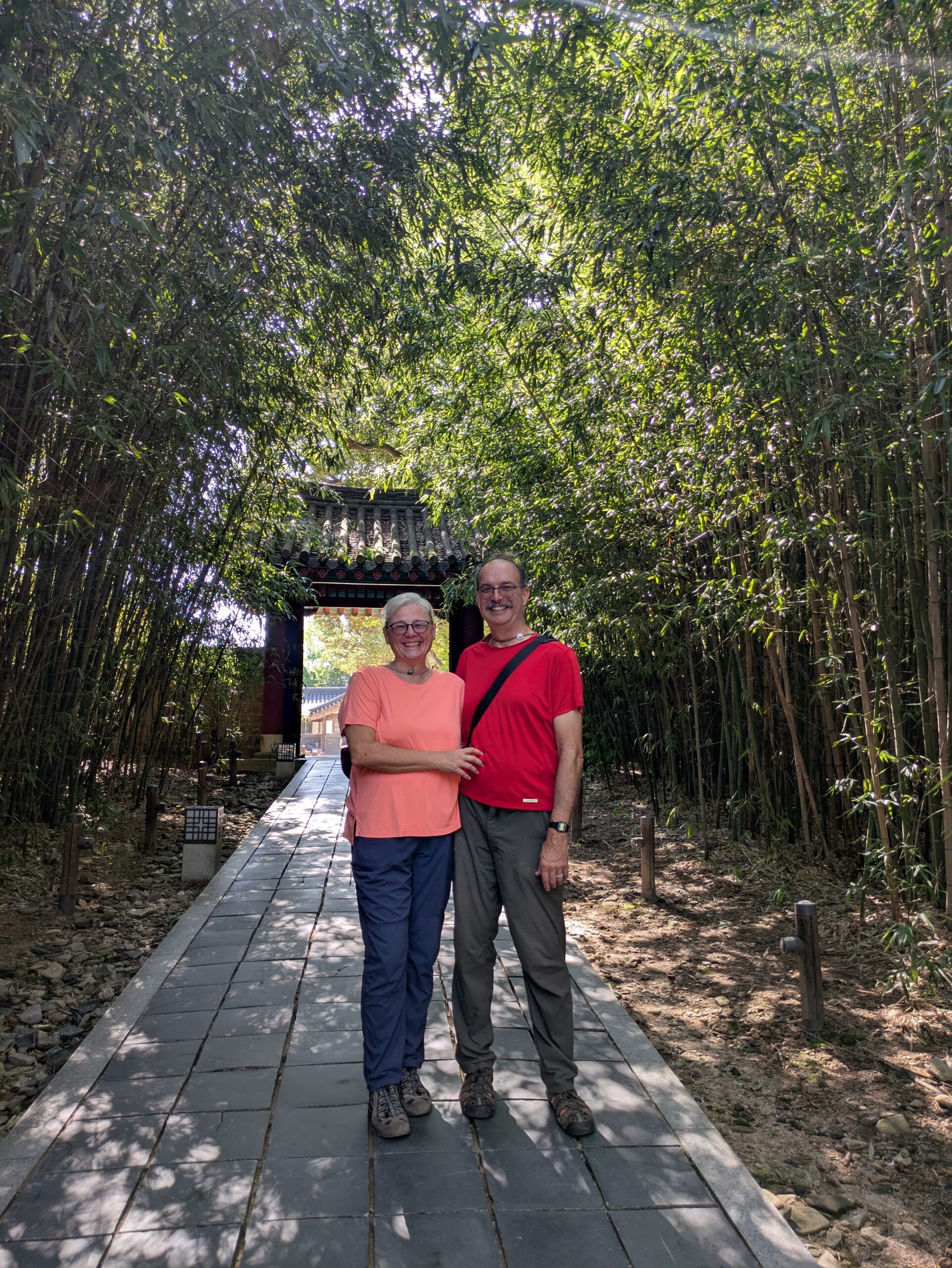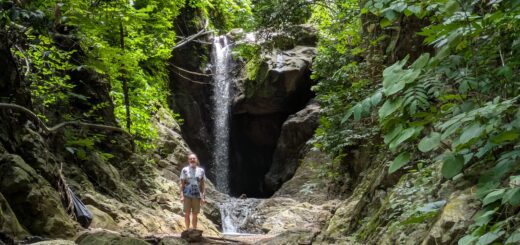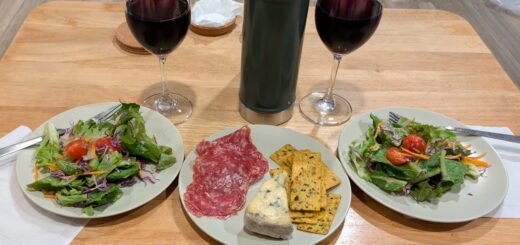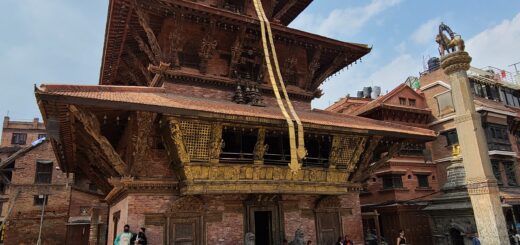Jeonju, Korea #7

October 11,
We were awake by 0600, but I went back to sleep until almost 0800. I did not sleep well last night! ☹️ Our bed has some kind of a plastic liner that crinkles up and gets hot. Anyway, we got about having our Javas and breakfast of Muesli and yogurt. This Muesli is more like cereal- corn flakes and crumbles.
We set out walking to the Hanok Village. We came in a different way- seeing a cute sculpture with a cat figurine sitting with a fishing pole. What fun! Anyway, we have another free walking tour we were interested in. The walking tour is free, but it is inside The Gyeonggijeon Shrine site, which has an entry fee. Jeff bought us tickets (3,000 KRW each or $2.10) and we waited for the guide. The guides all showed up and we ended up with the same guide from yesterday… maybe, she’s the English speaking guide. We had a larger group. There were three other couples: New Zealanders, Australians, and Germans. After introductions we set off.
Our guide took us off to the main hall, right off. The original shrine was built in 1410. Outside the main hall, she explained that this main hall was protected from or escaped destruction at the hands of the Japanese in the late 1500’s. There were six rusty pots of water lining the walkway into the hall. She explained they were for fire extinguishing, but despite them, the hall managed to burn down in the 1700’s. This hall is where a copy of the portrait of King Taejo was on display. The portrait is a National Treasure of Korea. After viewing it, we were led to the National Archives.
First we all had a photo op in front of an entry way lined with bamboo. It was famous due to being in some Korean Dramas. Then she showed us a plum tree that was almost laying on the ground. It is 110 years old and planted by the Japanese. At the National Archives, we climbed a steep stairway up and into it because this building was up on stilts. Once we were all inside, our guide told us that there were official writers who told of everything that happened daily with the king. These writers, called Sakwans, even made their own paper. She gave an example: if the king fell off a horse, they would record it. And if he tried to talk them out of the writing, they would record this as well! What a way to keep the king honest!!! Fascinating! She pointed out an enclosed sample writing, saying of course, it is in Chinese… like we would know or could tell. I almost laughed out loud, but she was serious, so I stifled it! 😂 We all perused. I read from a placard – that these Annals were registered as a UNESCO Memory of the World in 1997 and are now protected as cultural heritage of humanity! They document the Joseon Dynasty. We all finished and climbed back down out of the building. Our guide collected us saying this was the end of the tour, but she gave us pointers on touring the rest of the Shrine area, and other things to do today in the village. So we all parted company, after we talked a bit with the Kiwis.
We went to the King Taejo Portrait Exhibition Gallery. This King is noted because he’s the first King/ founder of Joseon. There were a couple of videos in the Gallery. We watched them both. The first one had something to do with the four seasons. The second had the making of a copy of the Royal Portrait. This I found fascinating. Between the two videos and displays we were there 20 minutes. When we finished the gallery, we meandered through an annex part of the shrine area where buildings were set up to resemble places where food was made for the king, or sacrificial rites attended by the king; a well for water for the king; etc. Our guide had told us it was great for photos. It was set up for taking shots of working a mill in a hut, or the so-called “kitchen” areas, more like food prep with a fire.
Now we exited the Shrine and went across the street to the Jeondong Catholic Church (formal Cathedral). It is an impressive structure from the outside, all brick with a tall belfry. Once inside no pictures were allowed. It had high arches of brick from the exterior and white-wash walls. It is labeled as Romanesque style being the first of this style in Korea and the first western-style building in the Honam region, according to a placard. But also on the placard was listed at least seven martyrs killed on this site in late 1790- early 1800’s. In 1908 the land where the people were killed was bought and this church was built. In 1931 the church was consecrated, becoming a cathedral 1937. In 1960 the cathedral was moved and this building went back to church status. It is a crazy story, especially with all the martyrs. The structure is beautiful and a nice addition to the skyline in the village.
We walked back another route to our place and we actually walked through the current diocesan, (not intentionally, but it was a nice closure to the prior story). We went to a bakery for a light snack “lunner.” When we arrived back at our place we just cooled off and relaxed. We ate our bread with some garlic cream cheese spread – very nice.
Around 1810 we went back out to go to an evening dancing performance. Our guide told us this is only performed here one time a year for two performances. We took the bus for the first time in Jeonju. We arrived around 1830. It is another free performance, but they had very professional program booklets they handed out, titled: ‘Reenactment of the Jeonra Gamyeong Gyobangmu- The flower of dance has bloomed at Sonhwadang.’ (It was in Korean, I translated it later). The dances are based on traditional dances of the Joseon era. Much of the exact dance moves seem to have been lost, but the choreographer has been able to find enough to put together a few different sets. There were seven sets. The first and fourth were four ladies dancing around in very controlled symmetric movements. In the first set they ended dancing with swords and in the fourth set they danced around and beat a drum- synchronized. The second set was a man that did the same controlled movement style, but he seemed to be about being a superior dandy or elegant – different. The third was a fun one. Overall it involved the principle of rewarding good and punishing evil, according to the program. A chaste young woman becomes lewd, a scholar becomes corrupt, and a monk breaks precepts. It amounted to people ‘flittering’ around and gained a little audience participation. The number five dance was called a towel dance- a lady danced about with a white towel symbolizing purity with many emotions. It was graceful. The sixth dance was a ball-throwing dance. Women danced about throwing a ball at a board with a hole in it. If you succeeded a flower adornment was placed in your hair, but missing an older lady painted a mark on your face. The last set was the Sogo dance. A lady danced about skillfully playing a drum and the audience was drawn in clapping with her.
It was a great show!!! So glad we went! We walked back to our place and crashed.









